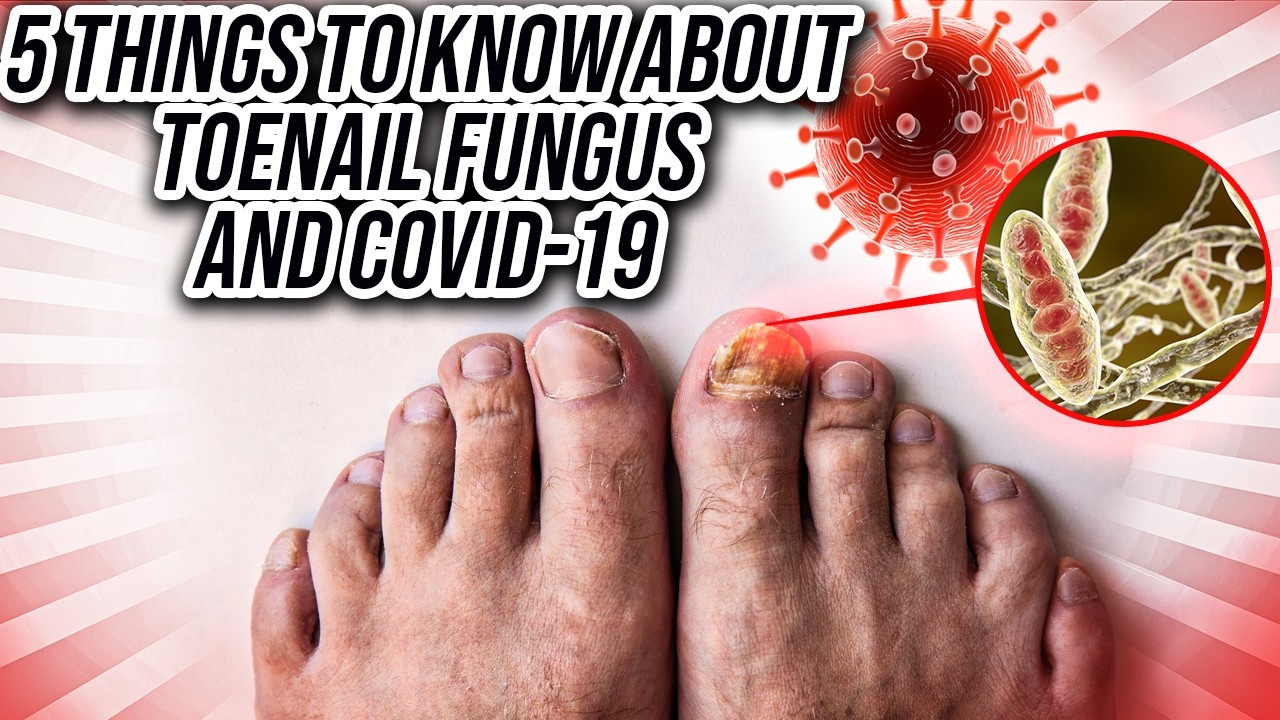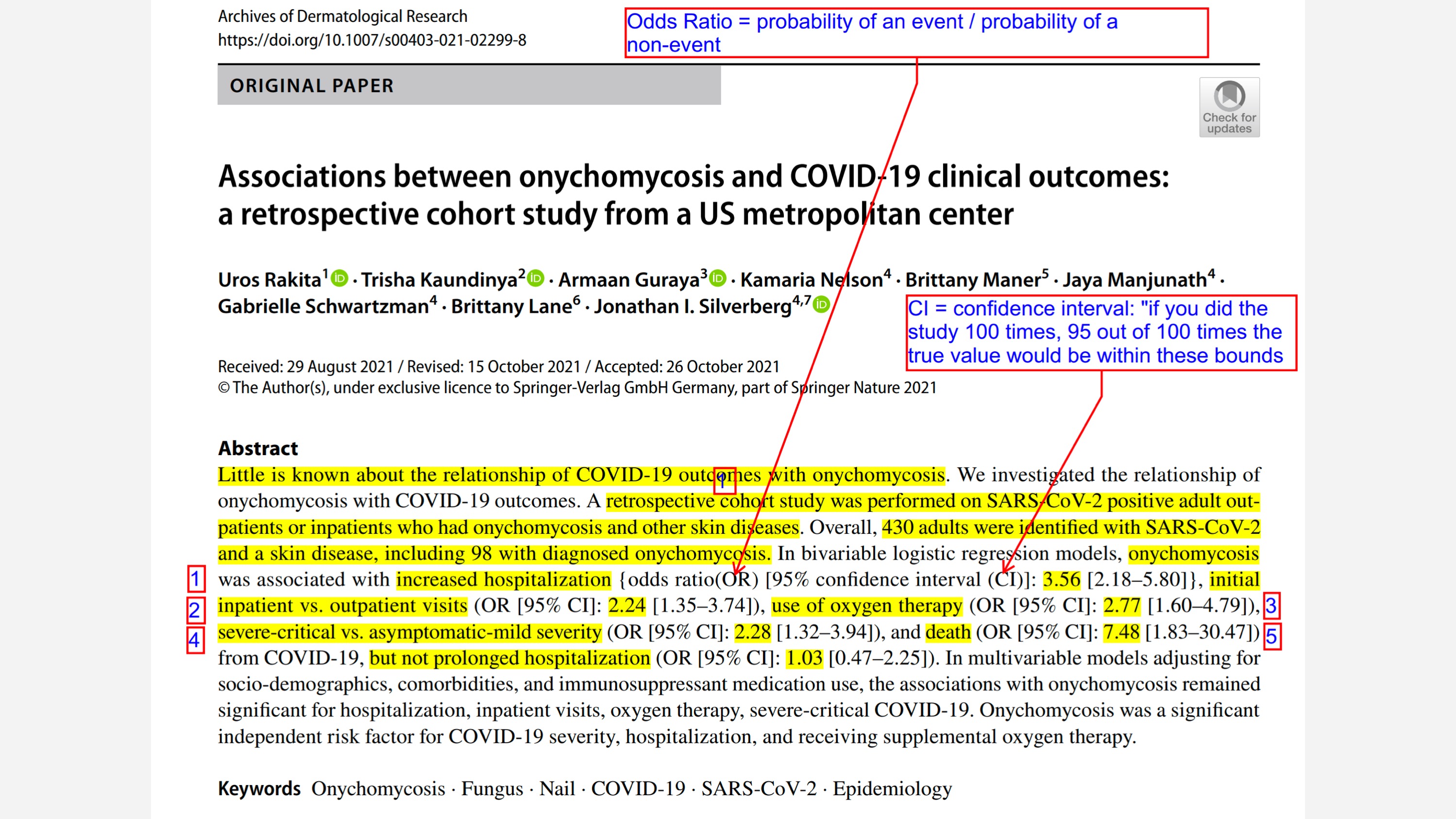5 Things To Know About Toenail Fungus And COVID-19

Hi there. My name is Dr. Cameron Jones and I'm an environmental microbiologist and public health scientist. For many of you and including all of us here in Australia, we are entering summer. Now, that's fantastic because sunny weather means shorts and sandals and flip flops and Havaianas. Now, many of us that might be a problem because of something called foot fungus. When I was looking into the research literature this year for really interesting papers to bring to you I found this particular paper. Which found a high correlation between a particular type of skin complaint that affects the nails, not just on your toenails but preferentially on your toenails and the experience of COVID 19. So I'm going to be getting through the research shortly, but before that I want to bring to you an overview of fungal foot infections. So today we're going to be focusing on five things to know about toenail fungus and COVID 19. Now I know that's a particularly scary topic and it's something you might not want to be thinking about.
But in order to bring this to you in the most effective manner possible, I've chosen to highlight some of the key questions which I'm asked about all the time and we're going to go through and focus on these key connections and questions and answers now. So the first one is what are the symptoms of nail fungus? Well, it has a very high prevalence in the community. In fact 10% of the population has a fungal nail infection at any point in time and typical symptoms include pain caused by cracked or fragile nails and they may often be thick and discolored and that characteristic yellow, brown or white appearance may cause embarrassment in social and work situations. Now, it doesn't sound very good does it? But you need to understand some of these key question and answers before we can move into the risks of this and what you can do to overcome a fungal nail infection, but we'll track through each of the questions. So who is most likely to get a fungal nail infection?
Well anyone, but especially those with diabetes, anyone with a weakened immune system, those with blood circulation problems, anyone who is suffering from athletes foot or has a nail allergy. Again, we need to recognize that nail injuries can occur for example if you stub your foot and not just from some sort of impact blow. So we need to be aware of this and be mindful of it. Now, what is the medical or technical term for nail fungus? Well, it's a bit of a mouthful, but if you research any of this for yourself on PubMed or on Google, you'll find that the medical for the fungus that affects the nails is called onychomycosis. Now, is this the same as foot fungus? Essentially no. Foot fungus is a fungal skin infection like athletes foot and there are other fungi as well. But those that preferentially colonize the nail bed are called dermatophyte fungi and the most common one is called Trichophyton rubrum and there are definitely other opportunistic fungi such as Alternaria, Fusarium, Aspergillus and yeasts. But Candida and other yeasts are also definitely affecting the foot as well.
I'm always going on about these opportunistic pathogens, because water damaged buildings are a prime reservoir of a lot of those fungi that can cause secondary infections and certainly that's why we monitor water damage buildings for surface contamination as well. Now let's go through, how do you get onychomycosis? Well, these fungal and yeast pathogens get into these small cracks in the nail or surrounding the skin and cause an infection. You are probably wondering how we diagnose onychomycosis. Well, your healthcare practitioner or your doctor can undertake microscopy using a chemical called potassium hydroxide. Which looks at the nail clippings or scrapings under the microscope to look at what they actually appear like and here's a typical example. You can actually see the fungal hyphae under the microscope and that's what's causing the itchiness or the discoloration to the nail bed and that's what we definitely don't want. Now moving right through to the next question, how do we prevent a fungal nail infection?
Well, you obviously want to keep your feet clean and dry, clip your nails short, don't walk barefoot in public showers and look for signs of good hygiene at nail salons. Definitely don't share clippers or nail buffers with other people. Now you're probably wondering how do you treat fungal nail infection? Well, obviously you need to make an appointment with your medical practitioner or healthcare provider. That's really important, there are some definite antifungal treatments that can be utilized and I will highlight some of these now. Now worst case scenario the nail may need to be removed completely, but there are prescription antifungals. I certainly don't want to, I would never advocate people undertaking surgery unless it was absolutely necessary from a microbiologist point of view. Microbes, there's always a way to attack them and so I'd be discussing this with your healthcare practitioner to see whether or not some of the newer types of antifungal treatments would be suitable. Now, what are those? I'm going to highlight one or two of these now.
But I may as well do this now, this is something called photodynamic therapy and again all the links are going to be in the show notes. So you'll be able to click down below and get all of these academic papers. But now that we've sort of covered what fungal foot infections and fungal nail infections are. I want to highlight this really fascinating paper which came out in the research literature just this week and this is a really important publication. It essentially was looking at the associations between fungal nail infections and COVID 19 clinical outcomes. I have really put the abstract directly up online here because I really want to discuss this for the remainder of this presentation. In order to discuss this I want to make two definitions very clear in your mind. Whenever you are looking at especially medical research, there is something called the OR or the odds ratio and that describes the probability of an event which is then divided by the probability of a non-event.

So in this research paper the scientists was looking at determining whether or not there was a connection or a correlation between those who presented at hospital with COVID 19 symptoms and whether or not there was a connection with this underlying foot and nail fungal infection, and guess what? There was, and we're going to track through what the five dominant connections were between COVID 19 disease severity and what the scientists saw. But to define this I need to also talk about something called the CI, which is the confidence interval. You'll often see this in the research literature and the confidence interval can easily be defined as if you did the study a 100 times, 95 out of a 100 times the true value would be within these bounds. So what did the scientists discover? Well, they found that increased hospitalization was associated with the presence of onychomycosis and you can see that the odds ratio for that is 3.56. So that means this is 3.56 times more likely to occur if you have fungal nail infections and you can then see that the CI measures the confidence interval.
So we've stated that the people with fungal nail infections have an increased rate of hospitalization and the range spans 2.18 to 5.80 and the average is 3.56 times. So now we can track through now that we understand what the odds ratio means. So what is the connection between an initial inpatient versus outpatient visits? Again, we see that it's almost twice as likely that you'll be an inpatient if you have this fungal nail infection. Now, if your COVID 19 symptoms are particularly severe and you require oxygen therapy you're 2.77 times more likely to require that if you've got a fungal nail infection. Again we can also look at the fourth point, severe critical versus asymptomatic COVID 19 symptoms. Again it's almost double or it is double, 2.28 times more likely to be severe or critical if you have this underlying nail infection and of course the worst one death and you're 7.48 times more likely to have that outcome if you have a fungal nail infection.
So as I said, the links to this publication so you can read it for yourself are going to be in the show notes. I think it is a really salient paper because it focuses on something that you can see with your own eyes. So check out your own feet, check out those of other people and talk to your friends and family about fungal nail infections. They are particularly problematic and it's something that we should all be aware of and these sorts of studies highlight the fact that an immunocompromised status is going to make itself known and you can determine that in many cases just by looking down at your own toenails. In any case each week I bring you these really what I think are cutting edge research. More videos and free surveys are available, including an ebook which focuses on mold in the built environment. You can get that at my website at drcameronjones.com.
In any case each week I bring you new research straight out of the literature and describe it in plain and simple terms so that you can optimize your own health and wellbeing. Anyway, bye for now, see you next week.
Watch the Livestream:
REFERENCES:
Rakita U, Kaundinya T, Guraya A, Nelson K, Maner B, Manjunath J, Schwartzman G, Lane B, Silverberg JI. Associations between onychomycosis and COVID-19 clinical outcomes: a retrospective cohort study from a US metropolitan center. Arch Dermatol Res. 2021 Nov 12. doi: 10.1007/s00403-021-02299-8. Epub ahead of print. PMID: 34773138. https://link.springer.com/article/10.1007%2Fs00403-021-02299-8
Elewski B. E. (1998). Onychomycosis: pathogenesis, diagnosis, and management. Clinical microbiology reviews, 11(3), 415–429. https://doi.org/10.1128/CMR.11.3.415
Robres P, Aspiroz C, Rezusta A, Gilaberte Y. Usefulness of Photodynamic Therapy in the Management of Onychomycosis. Actas Dermosifiliogr. 2015 Dec;106(10):795-805. English, Spanish. doi: 10.1016/j.ad.2015.08.005. Epub 2015 Oct 1. PMID: 26427737.

